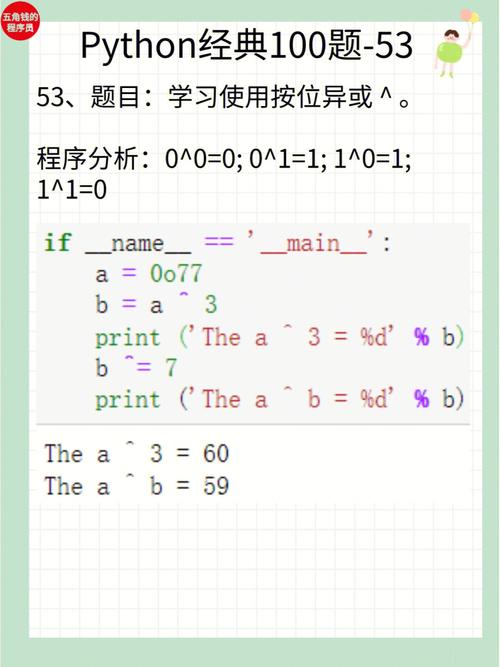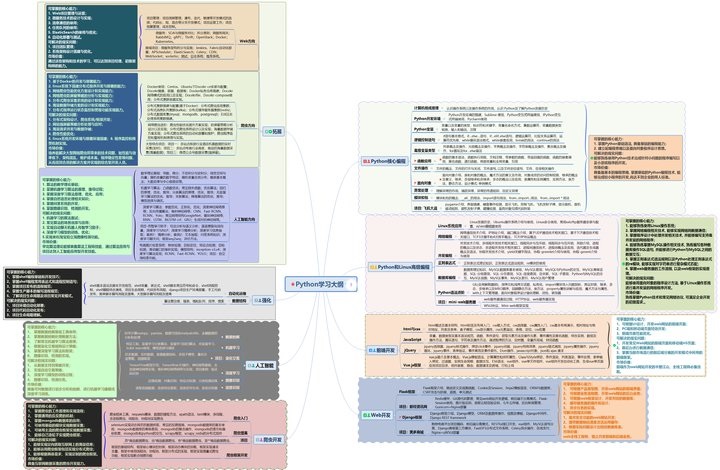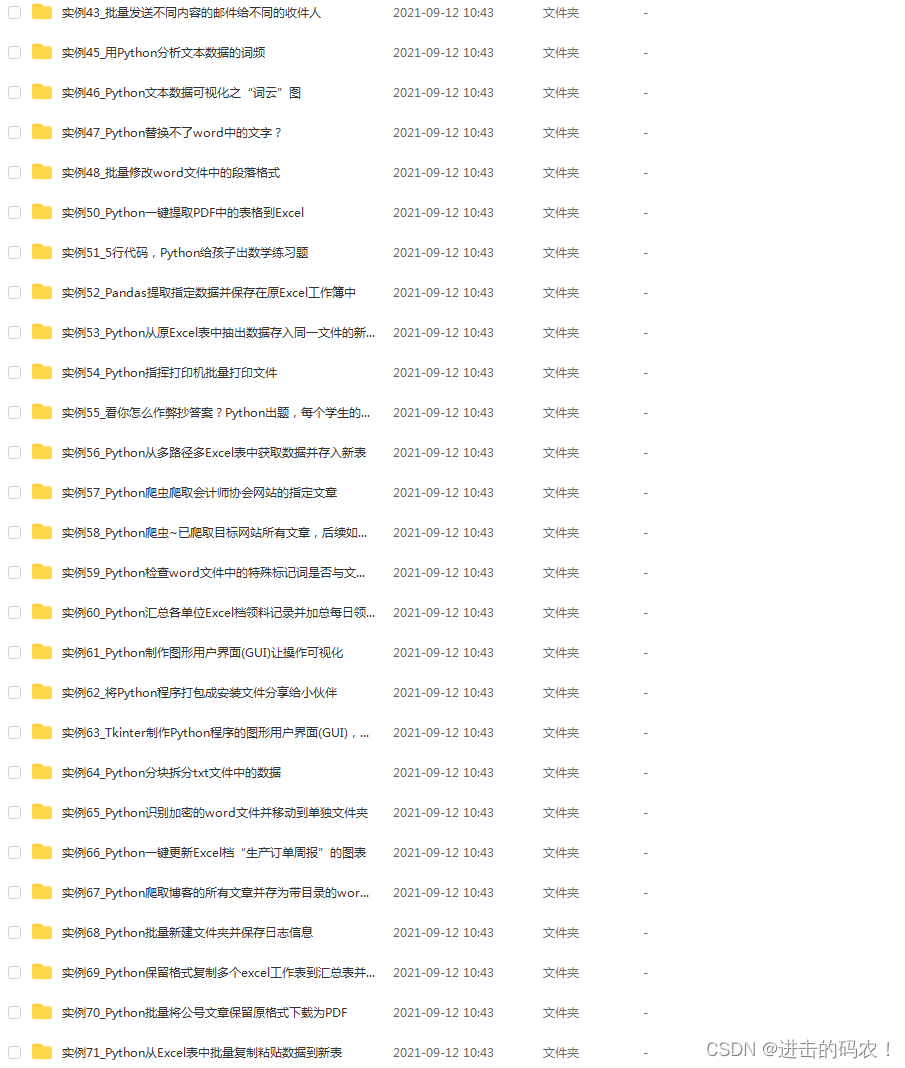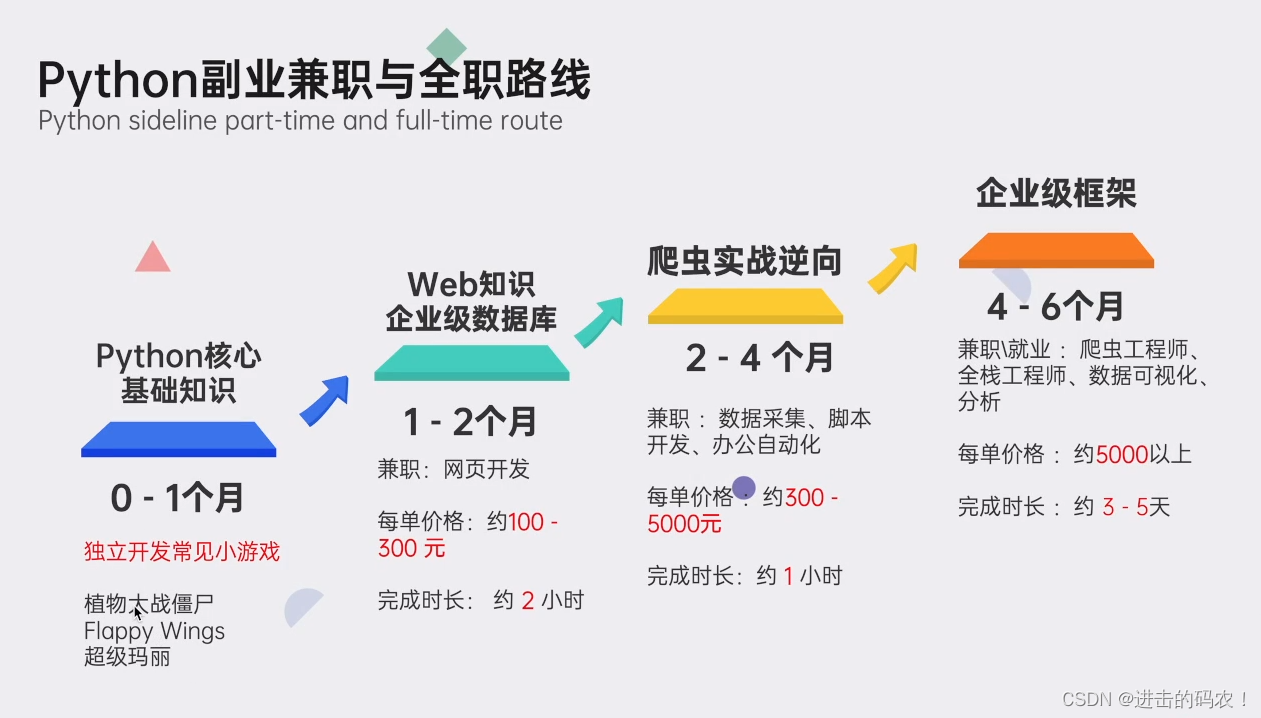大家好,小编来为大家解答以下问题,python基础题库100题及答案,python基础题目及答案,今天让我们一起来看看吧!

学习永远都是“理论”与“实践”相结合效果最好。
这里有python入门的120个基础练习(1~40),希望对你有用学习python用什么书好。
01-Hello World
python的语法逻辑完全靠缩进,建议缩进4个空格。 如果是顶级代码,那么必须顶格书写,哪怕只有一个空格也会有语法错误。 下面示例中,满足if条件要输出两行内容,这两行内容必须都缩进,而且具有相同的缩进级别。
print('hello world!')
if 3 > 0:
print('OK')
print('yes')
x = 3; y = 4 # 不推荐,还是应该写成两行
print(x + y)
02-print
print('hello world!')
print('hello', 'world!') # 逗号自动添加默认的分隔符:空格
print('hello' + 'world!') # 加号表示字符拼接
print('hello', 'world', sep='***') # 单词间用***分隔
print('#' * 50) # *号表示重复50遍
print('how are you?', end='') # 默认print会打印回车,end=''表示不要回车
03-基本运算
运算符可以分为:算术运算符、比较运算符和逻辑运算符。优先级是:算术运算符>比较运算符>逻辑运算符。最好使用括号,增加了代码的可读性。
print(5 / 2) # 2.5
print(5 // 2) # 丢弃余数,只保留商
print(5 % 2) # 求余数
print(5 ** 3) # 5的3次方
print(5 > 3) # 返回True
print(3 > 5) # 返回False
print(20 > 10 > 5) # python支持连续比较
print(20 > 10 and 10 > 5) # 与上面相同含义
print(not 20 > 10) # False
04-input
number = input("请输入数字: ") # input用于获取键盘输入
print(number)
print(type(number)) # input获得的数据是字符型
print(number + 10) # 报错,不能把字符和数字做运算
print(int(number) + 10) # int可将字符串10转换成数字10
print(number + str(10)) # str将10转换为字符串后实现字符串拼接
05-输入输出基础练习
username = input('username: ')
print('welcome', username) # print各项间默认以空格作为分隔符
print('welcome ' + username) # 注意引号内最后的空格
06-字符串使用基础
python中,单双引号没有区别,表示一样的含义
sentence = 'tom\'s pet is a cat' # 单引号中间还有单引号,可以转义
sentence2 = "tom's pet is a cat" # 也可以用双引号包含单引号
sentence3 = "tom said:\"hello world!\""
sentence4 = 'tom said:"hello world"'
# 三个连续的单引号或双引号,可以保存输入格式,允许输入多行字符串
words = """
hello
world
abcd"""
print(words)
py_str = 'python'
len(py_str) # 取长度
py_str[0] # 第一个字符
'python'[0]
py_str[-1] # 最后一个字符
# py_str[6] # 错误,下标超出范围
py_str[2:4] # 切片,起始下标包含,结束下标不包含
py_str[2:] # 从下标为2的字符取到结尾
py_str[:2] # 从开头取到下标是2之前的字符
py_str[:] # 取全部
py_str[::2] # 步长值为2,默认是1
py_str[1::2] # 取出yhn
py_str[::-1] # 步长为负,表示自右向左取
py_str + ' is good' # 简单的拼接到一起
py_str * 3 # 把字符串重复3遍
't' in py_str # True
'th' in py_str # True
'to' in py_str # False
'to' not in py_str # True
07-列表基础
列表也是序列对象,但它是容器类型,列表中可以包含各种数据
**alist = [10, 20, 30, 'bob', 'alice', [1,2,3]]
len(alist)
alist[-1] # 取出最后一项
alist[-1][-1] # 因为最后一项是列表,列表还可以继续取下标
[1,2,3][-1] # [1,2,3]是列表,[-1]表示列表最后一项
alist[-2][2] # 列表倒数第2项是字符串,再取出字符下标为2的字符
alist[3:5] # ['bob', 'alice']
10 in alist # True
'o' in alist # False
100 not in alist # True
alist[-1] = 100 # 修改最后一项的值
alist.append(200) # 向**列表中追加一项
08-元组基础
元组与列表基本上是一样的,只是元组不可变,列表可变。
atuple = (10, 20, 30, 'bob', 'alice', [1,2,3])
len(atuple)
10 in atuple
atuple[2]
atuple[3:5]
# atuple[-1] = 100 # 错误,元组是不可变的
09-字典基础
# 字典是key-value(键-值)对形式的,没有顺序,通过键取出值
adict = {'name': 'bob', 'age': 23}
len(adict)
'bob' in adict # False
'name' in adict # True
adict['email'] = 'bob@tedu.cn' # 字典中没有key,则添加新项目
adict['age'] = 25 # 字典中已有key,修改对应的value
10-基本判断
单个的数据也可作为判断条件。 任何值为0的数字、空对象都是False,任何非0数字、非空对象都是True。
if 3 > 0:
print('yes')
print('ok')
if 10 in [10, 20, 30]:
print('ok')
if -0.0:
print('yes') # 任何值为0的数字都是False
if [1, 2]:
print('yes') # 非空对象都是True
if ' ':
print('yes') # 空格字符也是字符,条件为True
11-条件表达式、三元运算符
a = 10
b = 20
if a < b:
smaller = a
else:
smaller = b
print(smaller)
s = a if a < b else b # 和上面的if-else语句等价
print(s)
12-判断练习:用户名和密码是否正确
import getpass # 导入模块
username = input('username: ')
# getpass模块中,有一个方法也叫getpass
password = getpass.getpass('password: ')
if username == 'bob' and password == '123456':
print('Login successful')
else:
print('Login incorrect')
13-猜数:基础实现
import random
num = random.randint(1, 10) # 随机生成1-10之间的数字
answer = int(input('guess a number: ')) # 将用户输入的字符转成整数
if answer > num:
print('猜大了')
elif answer < num:
print('猜小了')
else:
print('猜对了')
print('the number:', num)
14-成绩分类1
score = int(input('分数: '))
if score >= 90:
print('优秀')
elif score >= 80:
print('好')
elif score >= 70:
print('良')
elif score >= 60:
print('及格')
else:
print('你要努力了')
15-成绩分类2
score = int(input('分数: '))
if score >= 60 and score < 70:
print('及格')
elif 70 <= score < 80:
print('良')
elif 80 <= score < 90:
print('好')
elif score >= 90:
print('优秀')
else:
print('你要努力了')
16-石头剪刀布
import random
all_choices = ['石头', '剪刀', '布']
computer = random.choice(all_choices)
player = input('请出拳: ')
# print('Your choice:', player, "Computer's choice:", computer)
print("Your choice: %s, Computer's choice: %s" % (player, computer))
if player == '石头':
if computer == '石头':
print('平局')
elif computer == '剪刀':
print('You WIN!!!')
else:
print('You LOSE!!!')
elif player == '剪刀':
if computer == '石头':
print('You LOSE!!!')
elif computer == '剪刀':
print('平局')
else:
print('You WIN!!!')
else:
if computer == '石头':
print('You WIN!!!')
elif computer == '剪刀':
print('You LOSE!!!')
else:
print('平局')
17-改进的石头剪刀布
import random
all_choices = ['石头', '剪刀', '布']
win_list = [['石头', '剪刀'], ['剪刀', '布'], ['布', '石头']]
prompt = """(0) 石头
(1) 剪刀
(2) 布
请选择(0/1/2): """
computer = random.choice(all_choices)
ind = int(input(prompt))
player = all_choices[ind]
print("Your choice: %s, Computer's choice: %s" % (player, computer))
if player == computer:
print('\033[32;1m平局\033[0m')
elif [player, computer] in win_list:
print('\033[31;1mYou WIN!!!\033[0m')
else:
print('\033[31;1mYou LOSE!!!\033[0m')
18-猜数,直到猜对
import random
num = random.randint(1, 10)
running = True
while running:
answer = int(input('guess the number: '))
if answer > num:
print('猜大了')
elif answer < num:
print('猜小了')
else:
print('猜对了')
running = False
19-猜数,5次机会
import random
num = random.randint(1, 10)
counter = 0
while counter < 5:
answer = int(input('guess the number: '))
if answer > num:
print('猜大了')
elif answer < num:
print('猜小了')
else:
print('猜对了')
break
counter += 1
else: # 循环被break就不执行了,没有被break才执行
print('the number is:', num)
20-while循环,累加至100
因为循环次数是已知的,实际使用时,建议用for循环
sum100 = 0
counter = 1
while counter < 101:
sum100 += counter
counter += 1
print(sum100)
21-while-break
break是结束循环,break之后、循环体内代码不再执行。
while True:
yn = input('Continue(y/n): ')
if yn in ['n', 'N']:
break
print('running...')
22-while-continue
计算100以内偶数之和。
continue是跳过本次循环剩余部分,回到循环条件处。
sum100 = 0
counter = 0
while counter < 100:
counter += 1
# if counter % 2:
if counter % 2 == 1:
continue
sum100 += counter
print(sum100)
23-for循环遍历数据对象
astr = 'hello'
alist = [10, 20, 30]
atuple = ('bob', 'tom', 'alice')
adict = {'name': 'john', 'age': 23}
for ch in astr:
print(ch)
for i in alist:
print(i)
for name in atuple:
print(name)
for key in adict:
print('%s: %s' % (key, adict[key]))
24-range用法及数字累加
# range(10) # [0, 1, 2, 3, 4, 5, 6, 7, 8, 9]
# >>> list(range(10))
# range(6, 11) # [6, 7, 8, 9, 10]
# range(1, 10, 2) # [1, 3, 5, 7, 9]
# range(10, 0, -1) # [10, 9, 8, 7, 6, 5, 4, 3, 2, 1]
sum100 = 0
for i in range(1, 101):
sum100 += i
print(sum100)
25-列表实现斐波那契数列
列表中先给定两个数字,后面的数字总是前两个数字之和。
fib = [0, 1]
for i in range(8):
fib.append(fib[-1] + fib[-2])
print(fib)
26-九九乘法表
for i in range(1, 10):
for j in range(1, i + 1):
print('%s*%s=%s' % (j, i, i * j), end=' ')
print()
# i=1 ->j: [1]
# i=2 ->j: [1,2]
# i=3 ->j: [1,2,3]
#由用户指定相乘到多少
n = int(input('number: '))
for i in range(1, n + 1):
for j in range(1, i + 1):
print('%s*%s=%s' % (j, i, i * j), end=' ')
print()
27-逐步实现列表解析
# 10+5的结果放到列表中
[10 + 5]
# 10+5这个表达式计算10次
[10 + 5 for i in range(10)]
# 10+i的i来自于循环
[10 + i for i in range(10)]
[10 + i for i in range(1, 11)]
# 通过if过滤,满足if条件的才参与10+i的运算
[10 + i for i in range(1, 11) if i % 2 == 1]
[10 + i for i in range(1, 11) if i % 2]
# 生成IP地址列表
['192.168.1.%s' % i for i in range(1, 255)]
28-三局两胜的石头剪刀布
import random
all_choices = ['石头', '剪刀', '布']
win_list = [['石头', '剪刀'], ['剪刀', '布'], ['布', '石头']]
prompt = """(0) 石头
(1) 剪刀
(2) 布
请选择(0/1/2): """
cwin = 0
pwin = 0
while cwin < 2 and pwin < 2:
computer = random.choice(all_choices)
ind = int(input(prompt))
player = all_choices[ind]
print("Your choice: %s, Computer's choice: %s" % (player, computer))
if player == computer:
print('\033[32;1m平局\033[0m')
elif [player, computer] in win_list:
pwin += 1
print('\033[31;1mYou WIN!!!\033[0m')
else:
cwin += 1
print('\033[31;1mYou LOSE!!!\033[0m')
29-文件对象基础操作
# 文件操作的三个步骤:打开、读写、关闭
# cp /etc/passwd /tmp
f = open('/tmp/passwd') # 默认以r的方式打开纯文本文件
data = f.read() # read()把所有内容读取出来
print(data)
data = f.read() # 随着读写的进行,文件指针向后移动。
# 因为第一个f.read()已经把文件指针移动到结尾了,所以再读就没有数据了
# 所以data是空字符串
f.close()
f = open('/tmp/passwd')
data = f.read(4) # 读4字节
f.readline() # 读到换行符\n结束
f.readlines() # 把每一行数据读出来放到列表中
f.close()
################################
f = open('/tmp/passwd')
for line in f:
print(line, end='')
f.close()
##############################
f = open('图片地址', 'rb') # 打开非文本文件要加参数b
f.read(4096)
f.close()
##################################
f = open('/tmp/myfile', 'w') # 'w'打开文件,如果文件不存在则创建
f.write('hello world!\n')
f.flush() # 立即将缓存中的数据同步到磁盘
f.writelines(['2nd line.\n', 'new line.\n'])
f.close() # 关闭文件的时候,数据保存到磁盘
##############################
with open('/tmp/passwd') as f:
print(f.readline())
#########################
f = open('/tmp/passwd')
f.tell() # 查看文件指针的位置
f.readline()
f.tell()
f.seek(0, 0) # 第一个数字是偏移量,第2位是数字是相对位置。
# 相对位置0表示开头,1表示当前,2表示结尾
f.tell()
f.close()
30-拷贝文件
拷贝文件就是以r的方式打开源文件,以w的方式打开目标文件,将源文件数据读出后,写到目标文件。
以下是【不推荐】的方式,但是可以工作:
f1 = open('/bin/ls', 'rb')
f2 = open('/root/ls', 'wb')
data = f1.read()
f2.write(data)
f1.close()
f2.close()
31-拷贝文件
每次读取4K,读完为止:
src_fname = '/bin/ls'
dst_fname = '/root/ls'
src_fobj = open(src_fname, 'rb')
dst_fobj = open(dst_fname, 'wb')
while True:
data = src_fobj.read(4096)
if not data:
break
dst_fobj.write(data)
src_fobj.close()
dst_fobj.close()
32-位置参数
注意:位置参数中的数字是字符形式的
import sys
print(sys.argv) # sys.argv是sys模块里的argv列表
# python3 position_args.py
# python3 position_args.py 10
# python3 position_args.py 10 bob
33-函数应用-斐波那契数列
def gen_fib(l):
fib = [0, 1]
for i in range(l - len(fib)):
fib.append(fib[-1] + fib[-2])
return fib # 返回列表,不返回变量fib
a = gen_fib(10)
print(a)
print('-' * 50)
n = int(input("length: "))
print(gen_fib(n)) # 不会把变量n传入,是把n代表的值赋值给形参
34-函数-拷贝文件
import sys
def copy(src_fname, dst_fname):
src_fobj = open(src_fname, 'rb')
dst_fobj = open(dst_fname, 'wb')
while True:
data = src_fobj.read(4096)
if not data:
break
dst_fobj.write(data)
src_fobj.close()
dst_fobj.close()
copy(sys.argv[1], sys.argv[2])
# 执行方式
# cp_func.py /etc/hosts /tmp/zhuji.txt
35-函数-九九乘法表
def mtable(n):
for i in range(1, n + 1):
for j in range(1, i + 1):
print('%s*%s=%s' % (j, i, i * j), end=' ')
print()
mtable(6)
mtable(9)
36-模块基础
每一个以py作为扩展名的文件都是一个模块。
star.py:
hi = 'hello world!'
def pstar(n=50):
print('*' * n)
if __name__ == '__main__':
pstar()
pstar(30)
在call_star.py中调用star模块:
import star
print(star.hi)
star.pstar()
star.pstar(30)
37-生成密码/验证码
此文件名为:randpass.py
思路:
1、设置一个用于随机取出字符的基础字符串,本例使用大小写字母加数字
2、循环n次,每次随机取出一个字符
3、将各个字符拼接起来,保存到变量result中
from random import choice
import string
all_chs = string.ascii_letters + string.digits # 大小写字母加数字
def gen_pass(n=8):
result = ''
for i in range(n):
ch = choice(all_chs)
result += ch
return result
if __name__ == '__main__':
print(gen_pass())
print(gen_pass(4))
print(gen_pass(10))
38-序列对象方法
from random import randint
alist = list() # []
list('hello') # ['h', 'e', 'l', 'l', 'o']
list((10, 20, 30)) # [10, 20, 30] 元组转列表
astr = str() # ''
str(10) # '10'
str(['h', 'e', 'l', 'l', 'o']) # 将列表转成字符串
atuple = tuple() # ()
tuple('hello') # ('h', 'e', 'l', 'l', 'o')
num_list = [randint(1, 100) for i in range(10)]
max(num_list)
min(num_list)
39-序列对象方法2
alist = [10, 'john']
# list(enumerate(alist)) # [(0, 10), (1, 'john')]
# a, b = 0, 10 # a->0 ->10
for ind in range(len(alist)):
print('%s: %s' % (ind, alist[ind]))
for item in enumerate(alist):
print('%s: %s' % (item[0], item[1]))
for ind, val in enumerate(alist):
print('%s: %s' % (ind, val))
atuple = (96, 97, 40, 75, 58, 34, 69, 29, 66, 90)
sorted(atuple)
sorted('hello')
for i in reversed(atuple):
print(i, end=',')
40-字符串方法
py_str = 'hello world!'
py_str.capitalize()
py_str.title()
py_str.center(50)
py_str.center(50, '#')
py_str.ljust(50, '*')
py_str.rjust(50, '*')
py_str.count('l') # 统计l出现的次数
py_str.count('lo')
py_str.endswith('!') # 以!结尾吗?
py_str.endswith('d!')
py_str.startswith('a') # 以a开头吗?
py_str.islower() # 字母都是小写的?其他字符不考虑
py_str.isupper() # 字母都是大写的?其他字符不考虑
'Hao123'.isdigit() # 所有字符都是数字吗?
'Hao123'.isalnum() # 所有字符都是字母数字?
' hello\t '.strip() # 去除两端空白字符,常用
' hello\t '.lstrip()
' hello\t '.rstrip()
'how are you?'.split()
'hello.tar.gz'.split('.')
'.'.join(['hello', 'tar', 'gz'])
'-'.join(['hello', 'tar', 'gz'])
关于Python技术储备
学好 Python 不论是就业还是做副业赚钱都不错,但要学会 Python 还是要有一个学习规划。最后大家分享一份全套的 Python 学习资料,给那些想学习 Python 的小伙伴们一点帮助!
朋友们如果需要这份完整的资料可以微信扫描下方CSDN官方认证二维码免费领取【保证100%免费】

一、Python学习大纲
Python所有方向的技术点做的整理,形成各个领域的知识点汇总,它的用处就在于,你可以按照上面的知识点去找对应的学习资源,保证自己学得较为全面。
二、Python必备开发工具

三、入门学习视频

四、实战案例
光学理论是没用的,要学会跟着一起敲,要动手实操,才能将自己的所学运用到实际当中去,这时候可以搞点实战案例来学习。
五、python副业兼职与全职路线


👉[[CSDN大礼包:《python兼职资源&全套学习资料》免费分享]](安全链接,放心点击)





















 11万+
11万+











 被折叠的 条评论
为什么被折叠?
被折叠的 条评论
为什么被折叠?








